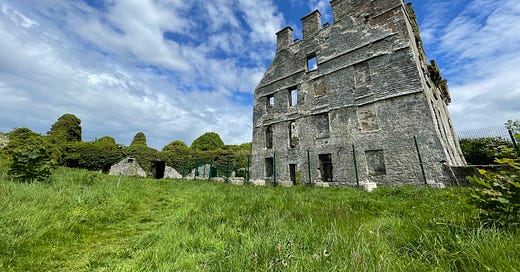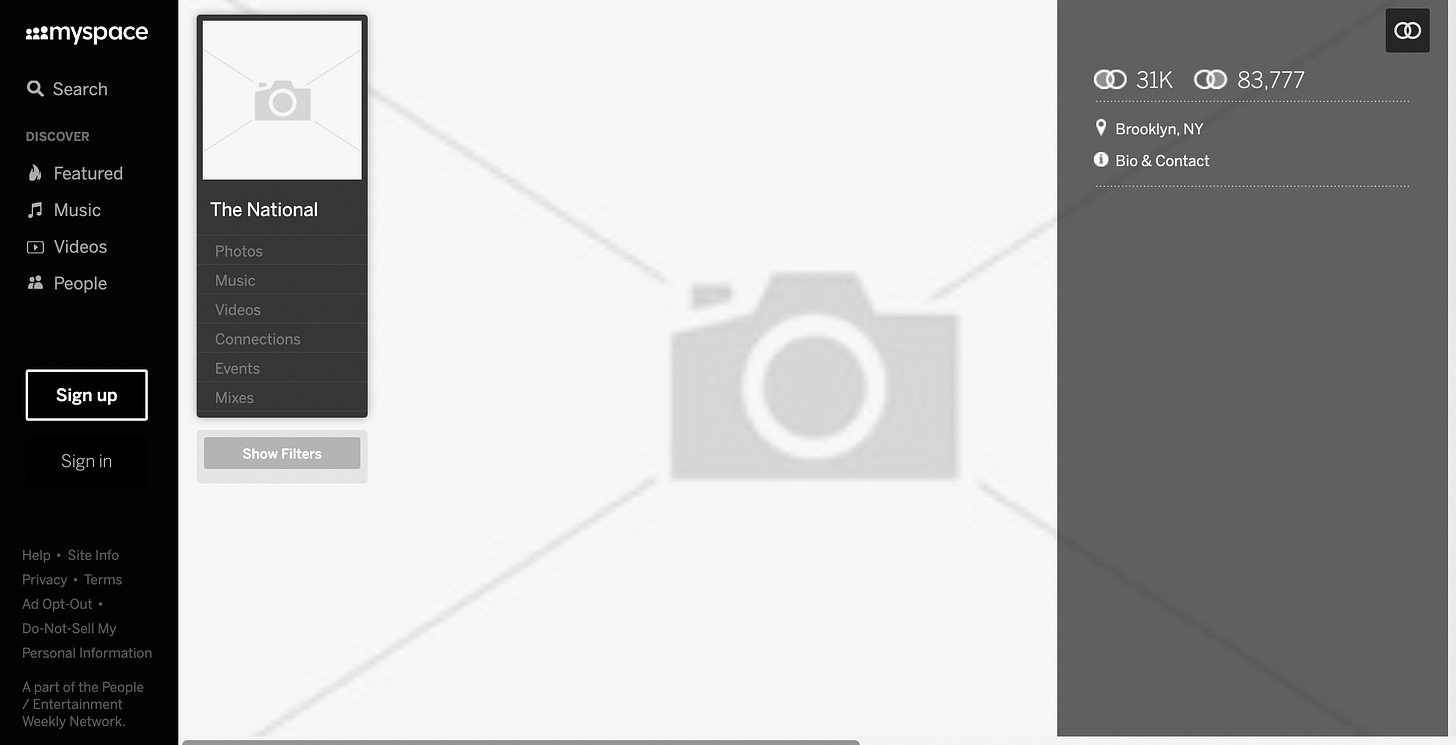Watching the ruins of social media
On the eve of the TikTok ban, thoughts on how social media becomes a ghost town.
Editor’s note: I planned to send this at the first of the month, but it felt… more relevant this weekend.
On a trip to Ireland in May, my friend and I visited the ruins of Menlo Castle in Galway.
The stone structure dates back to the 16th century, and after surviving some 400 years, the damn thing burned in 1910. So, it sits on the bank of the River Corrib and the remaining walls endure 30-somethings machine-gunning photos bound for Instagram.
The ruins of a castle are so tangible. They seem wholly permanent in their decay. More than a few times, I’ve Googled to find photos of what the building used to look like when it had, uh, floors.
In the last few months, I’ve been thinking a lot about ruins, but in the context of social media networks – those other places humans live their lives, digitally, at least. There’s been so much discussion around the transformation of Twitter into X (what veteran tech journalist Kara Swisher refers to as a “Nazi porn bar”), and now 170 million American TikTok users are waiting to see if their beloved app will brick at midnight.
The quirk about ruins is we tend to think about them in the binary of before and after. When I look at Menlo Castle, I don’t really visualize the fire that ripped through the building. But in this moment, particularly this weekend, I think we’re all on the banks watching social media burn.
Social media’s cow pasture era
It turns out, I’m not the only one who’s stood in the middle of ruins and hummed “It Could Happen to You.”
Jamie Cohen is a digital culture expert and associate professor at CUNY Queens College. We chatted in December about social media ghost towns – what they might look like, how they could come to be, and the wildness of watching it happen.
“We’re good with ruins. We’re good with going to Pompeii, we’re good with going to Rome, but we’re not good with watching the town turn into a cow pasture,” Cohen said.
You can visualize the Roman Forum in 44 BC in the wake of Julius Caesar’s assassination, and you can stand near the crumbling pillars now, but you probably don’t think much about the hundred of years in between when the Forum was buried and used as, yes, a cow pasture.
Social media is in its cow pasture era. Another way to think about this: Journalist and Sci-Fi writer Cory Doctorow’s delightful term, enshittification – the deterioration in the quality of online platforms and products.
“We’re all living through the enshittocene, a great enshittening, in which the services that matter to us, that we rely on, are turning into giant piles of shit. It’s frustrating. It’s demoralizing. It’s even terrifying,” Doctorow explains on his site.
It is genuinely weird to witness.
We’ll meet again. Maybe?
By necessity, there’s a decision to be made, even through inaction, about whether to let a place fully deteriorate.
Since Elon Musk bought Twitter in 2022, hoards of users packed their wares and left. And after the election, yet another exodus unfolded – some reports said 115,000 people deleted their accounts on Nov. 6. If TikTok does shut down overnight, the effect will be more eviction than departure. Even before TikTok’s fate drew so near, creators were hurriedly trying to shepherd their followers to other platforms – their backup accounts — the Reels and YouTube Shorts of it all.
Ask any sheepdog, getting a flock from point A to B isn’t easy. I suspect many haven’t or won’t move from one platform to the next. Therein lies some of the consequence.
For better or worse, something will be lost along the way. Online communities, tenuously rallying around some guy who posts videos about the cats he meets on his mail route, will take a hit. For every individual who perhaps found some camaraderie in talking to strangers about fantasy romance novels, some small void will form in the periphery of their brain.
Or maybe it’ll be the shattering revelation that any of our social networks (in the literal sense) is smaller and thinner than the follower counts on our profiles.
Can the paint and plaster chip off a comments section?
What to leave behind
The creation of a social media ghost town doesn’t have to be tragic, though. (Even if Hank Green singing the fish song in the dark makes you want to weep.) Cohen pointed out that in the proliferation of Twitter clones, old familiar problems like hateful behavior also get replicated, instead of left in the dust to disappear.
“We go through these architectural styles throughout history, but underneath it are these beams and structures,” he said.
And look, there are some baller reasons for using beams. They’re a classic. We stan structural integrity. Everything built on top of them – the beliefs, attitudes, moods, styles, and aesthetics are designed by people, he explained. Any community can decide “yes” to the beams, “no” to the shag carpets.
All that requires some collective stance, one that Cohen says he hasn’t really seen. The nostalgia is heavy right now for the TikTok dances of yore. Never mind the way the algorithm (like so many other platforms’ algorithms) has reportedly driven teenagers to eating disorder content, self-harm and God knows what else. For those kids, the app’s been a pile of rubble. Amid the emotional goodbyes and migration to Instagram or RedNote, there doesn’t seem to be much talk of how to improve. And to some extent, it’s beyond the control of any one creator.
Ruined, already
To be sure, social media networks have already passed into obscurity in the last 15 years. Remember Ping from Apple? Or Peach?
MySpace, once a cultural and social force, a driver of rank-based social dynamics, bad HTML and high-angle selfies, once sold for $580 million and was the fifth most-visited site on the internet.
The MySpace era was short-lived though. By 2009, Facebook racked up more monthly users, and it felt like MySpace was a stepping stone to some larger destination. Now, the average site visit lasts about 1 minute and 25 seconds, according to Similarweb.
It feels eerie to visit the MySpace for a band I loved in college. Aside from a handful of tracks on the page, almost everything else is blank.
There’s an unease to being in a place where the structures stand but the people are gone. Cohen talked about ghost towns having two qualities: The brokenness has to be maintained. Also, no one can move back in.
Whether there will ever be any novelty in roaming around what’s left of Twitter as it moves farther and farther to the fringes remains to be seen, as Cohen noted.
For TikTok, the surrealness will come from the fact that there’s a big gate with all the Americans on one side and a still-hopping platform on the other. It’s like getting banned from the mall in the ‘90s. It won’t so much be that TikTok is the ghost town, but rather the Americans are the ghosts.
Back home in Nashville, I know Menlo Castle is still there. I also know that within a few decades, no one would build such a structure without smoke alarms and a sprinkler system. In the right circumstances, tech and regulation like building codes can be forces for good.
For now, we’re stuck weathering the ruins as they happen. Maybe on the other side, there will be something to look at and learn from.
This week’s (P)doom: < 8%
– Erin
Jetsam: Many thanks to Jamie Cohen – be sure to check out his newsletter, New Media Homework. He’s also just published the book, “Critical Internet Literacies: Reconsidering Creativity, Content, and Safety Online.”







